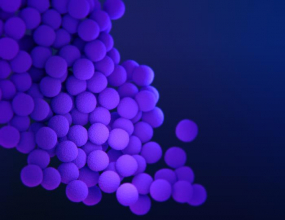Combatting MRSA infection
November 19, 2021

VBS Professor Yinduo Ji and his research team recently published the paper, "Contributions of Coagulase and Its Regulator SaeRS to Lethality of CA-MRSA 923 Bacteremia," in Pathogens. The paper analyses Staphylococcus aureus, which is a critical human pathogen that can often cause skin and soft tissue infections and sometimes leads to serious systematic infections such as pneumonia, endocarditis, and toxic shock syndrome. The continuous emergence of methicillin-resistant S. aureus (MRSA), including hospital-acquired (HA)-MRSA and community-acquired (CA)-MRSA has caused public health concerns worldwide.
Coagulase is a critical factor for distinguishing Staphylococcus aureus and coagulase-negative Staphylococcus. Our previous studies demonstrated that the null mutation of coagulase (coa) or its direct regulator, SaeRS, significantly enhanced the ability of S. aureus (CA-MRSA 923) to survive in human blood in vitro. This led us to further investigate the role of coagulase and its direct regulator, SaeRS, in the pathogenicity of CA-MRSA 923 in bacteremia during infection. In this study, we found that the null mutation of coa significantly decreased the mortality of CA-MRSA 923; moreover, the single null mutation of saeRS and the double deletion of coa/saeRS abolished the virulence of CA-MRSA 923. Moreover, the mice infected with either the saeRS knockout or the coa/saeRS double knockout mutant exhibited fewer histological lesions and less neutrophils infiltration in the infected kidneys compared to those infected with the coa knockout mutant or their parental control. Furthermore, we examined the impact of coa and saeRS on bacterial survival in vitro. The null mutation of coa had no impact on bacterial survival in mice blood, whereas the deletion mutation of saeRS or coa/saeRS significantly enhanced bacterial survival in mice blood. These data indicate that SaeRS plays a key role in the lethality of CA-MRSA 923 bacteremia, and that coagulase is one of the important virulence factors that is regulated by SaeRS and contributes to the pathogenicity of CA–MRSA 923.
Most MRSA isolates are resistant to multiple low-cost antibiotics, which in turn limits therapeutic choices to treat MRSA-associated infections. Therefore, a better understanding of the pathogenesis of S. aureus, including HA-MRSA and CA-MRSA, enables Ji's research team to develop an alternative strategy to combat MRSA infections.
In addition, Ji and his research team recently published the paper, "Identification of cbiO Gene Critical for Biofilm Formation by MRSA CFSa36 Strain Isolated from Pediatric Patient with Cystic Fibrosis," in Pathogens. The paper examines Staphylococcus aureus, especially methicillin-resistant S. aureus (MRSA), which has a detrimental effect on the respiratory care of pediatric patients with cystic fibrosis.